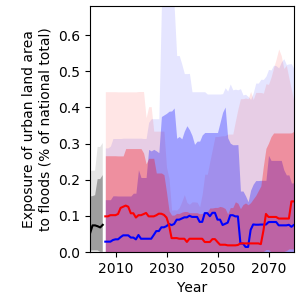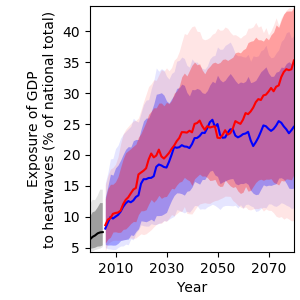Mauritania: Infrastructure
Climate change is expected to significantly affect Mauritania’s infrastructure through extreme weather events. High precipitation amounts can lead to the flooding of roads, while high temperatures can cause roads, bridges and protective structures to develop cracks and degrade more quickly. This will require earlier replacement and lead to higher maintenance and replacement costs. The near-total absence of passenger railways and limited airport facilities increase Mauritania’s reliance on road transportation [23]. The country has only 2 743 km of paved roads, which is one of the lowest densities on the continent [23]. While some roads become impassable during the rainy season, cutting off villages and rural communities, others are obscured by drifting sand during the dry season [23]. Investments will have to be made to build climate-resilient and safe road networks.
Extreme weather events will also have devastating effects on human settlements and economic production sites, especially in urban areas with high population densities like Nouakchott or Nouadhibou. Informal settlements are particularly vulnerable to extreme weather events: Makeshift homes are often built in unstable geographical locations including steep slopes or river banks, where flooding can lead to loss of housing, contamination of water, injury or death. Dwellers usually have low adaptive capacity to respond to such events due to high levels of poverty and a lack of risk-reducing infrastructures. For example, heavy precipitation events during the 2019 rainy season caused flooding in the region of Guidimakha in southern Mauritania, affecting 33 600 people [24]. The city of Sélibaby was hit particularly hard, recording damages to houses, markets and infrastructure as well as disruptions to water and energy supplies. Flooding and droughts will also affect hydropower generation: Together with Senegal and Mali, Mauritania shares the Manantali Dam, which has a total installed capacity of 200 MW and which is located on the Bafing River in Mali, a tributary of the Senegal River [25]. However, variability in precipitation and climatic conditions could severely disrupt hydropower generation in the whole region.
Despite the risk of infrastructure damage being likely to increase, precise predictions of the location and the extent of exposure are difficult to make. For example, projections of river flood events are subject to substantial modelling uncertainty, largely due to the uncertainty of future projections of precipitation amounts and their spatial distribution, affecting flood occurrence (see also Figure 4). In the case of Mauritania, median projections show almost no change in national road exposure to river floods (Figure 13). In the year 2000, 0.4 % of major roads were exposed to river floods at least once a year. By 2080, this value is projected to not change under RCP2.6 and to decrease to 0.3 % under RCP6.0. In a similar way, exposure of urban land area to river floods is projected to change only marginally under RCP6.0 from 0.05 % in 2000 to 0.14 % in 2080, with no change under RCP2.6 (Figure 14).


With the exposure of the GDP to heatwaves projected to increase dramatically from around 6 % in 2000 to 25 % (RCP2.6) and 35 % (RCP6.0) by 2080 (Figure 15), it is recommended that policy planners start identifying heat-sensitive economic production sites and activities, and integrating climate adaptation strategies such as improved solar-powered cooling systems, “cool roof” isolation materials or switching the operating hours from day to night [26].

References
[23] Logistics Cluster and WFP, “Mauritanie Infrastructures Logistiques,” 2020. Online available: https://dlca.logcluster.org/display/public/DLCA/2+Mauritania+Infrastructures+Logistiques [Accessed: 14-Jul-2020].
[24] IFRC, “Emergency Plan of Action (EPoA): Mauritania – Floods in Guidimakha,” Geneva, Switzerland, 2019.
[25] N. K. Dia, A. A. Bayod-Rújula, N. Mamoudou, M. Diallo, C. S. Ethmane, and B. O. Bilal, “Energy Context in Mauritania,” Energy Sources, Part B Econ. Plan. Policy, vol. 12, no. 2, pp. 182–190, 2017.


